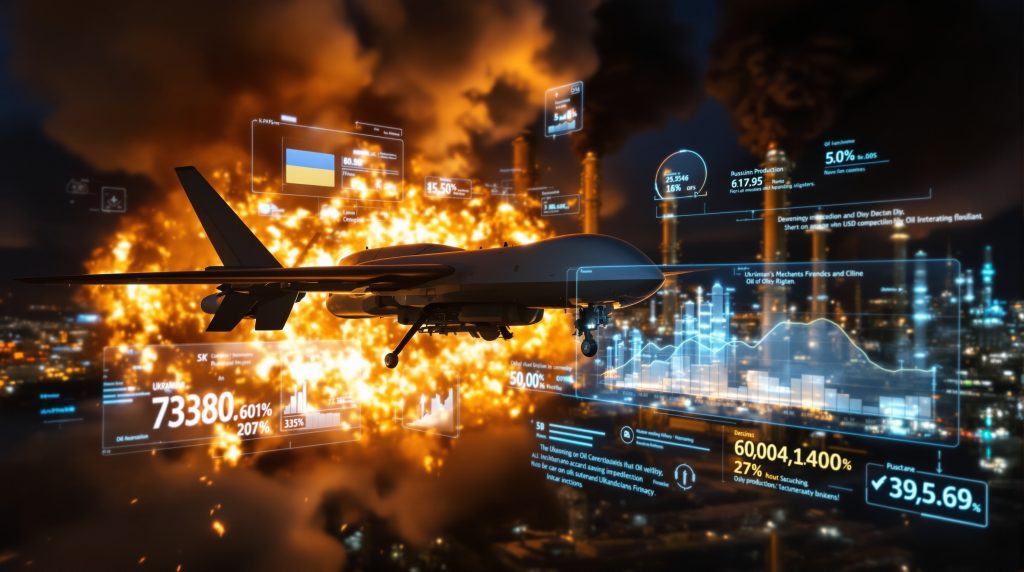Ukraine's Drone Offensive Against Russian Oil Refineries: Strategic Impact and Global Implications
Ukraine has intensified its campaign against Russian energy infrastructure, with drone strikes targeting major oil refineries across Russia. These strategic attacks aim to disrupt Russia's petroleum production capabilities and impact its war economy. The most recent attack on the Kirishi refinery in northwestern Russia demonstrates Ukraine's expanding reach and evolving tactics in this asymmetric warfare approach.
Recent Strike on Kirishi: A Strategic Target
The September 14, 2025 attack on the Kirishi refinery in Leningrad Oblast represents a significant escalation in Ukraine's drone campaign. As one of Russia's largest refineries with a processing capacity of 355,000 barrels per day (17.7 million metric tons annually), the facility plays a crucial role in Russia's northwestern energy infrastructure. The strike reportedly caused significant damage to processing units, potentially reducing the refinery's operational capacity by up to 40% according to preliminary assessments.
Pattern of Escalating Attacks
This attack follows a systematic campaign targeting Russia's refining capacity since early 2025:
- Multiple coordinated strikes on facilities in the Volga region
- Attacks on southern refineries including Novoshakhtinsk
- Strategic strikes against storage facilities and distribution networks
- Growing focus on facilities closer to major population centers
What Impact Have These Drone Strikes Had on Global Oil Markets?
The Ukrainian drone campaign has created ripple effects beyond the immediate tactical objectives, influencing global oil prices and market sentiment. These market movements reflect the interconnected nature of global energy systems.
Oil Price Movements and Market Response
Following the Kirishi refinery attack, Brent crude prices rose approximately 0.4% to $67.29 per barrel, while WTI crude gained 0.7% to reach $63.15. These modest but notable increases reflect market concerns about potential supply disruptions from one of the world's largest oil producers.
Analyst Perspectives on Market Implications
Market analysts have noted the potential for continued upward pressure on oil prices if the campaign persists. According to JPMorgan analyst Natasha Kaneva, these attacks "suggest a growing willingness to disrupt international oil markets," potentially adding "upside pressure on oil prices" if they continue or intensify. Furthermore, recent oil price rally analysis suggests that geopolitical tensions have become a more significant factor in price movements than traditional supply-demand fundamentals.
Supply Chain Vulnerabilities Exposed
The strikes have highlighted vulnerabilities in Russia's energy infrastructure:
- Refining bottlenecks that cannot be easily rerouted
- Challenges in protecting widespread energy assets
- Potential for cascading effects on fuel availability in certain regions
- Exposure of critical export infrastructure to long-range strike capabilities
How Has Ukraine Expanded Its Long-Range Strike Capabilities?
Ukraine has significantly evolved its domestic strike capabilities, reducing dependence on Western-supplied missiles while expanding its ability to hit targets deep within Russian territory.
Domestic Drone Development Program
Ukraine has rapidly developed multiple drone platforms capable of long-range strikes with diverse capabilities:
| Drone Model | Approximate Range | Payload Capacity | Notable Features |
|---|---|---|---|
| AQ-400 Scythe | 500+ km | 20-50 kg | Low radar signature |
| AN-196 Liutyi | 700+ km | 50-75 kg | All-weather capability |
| FP-1 | 600-1000 km | 10-20 kg | High autonomy |
These domestically produced systems have allowed Ukraine to maintain strike capabilities despite limitations on Western-supplied weapons.
The Flamingo Revolution: Ukraine's New Cruise Missile
Ukraine's most significant development is the FP-5 "Flamingo" cruise missile, which represents a major leap in indigenous capabilities:
- Range of up to 3,000 kilometers (1,900 miles)
- Payload capacity of 1,150 kilograms
- Current production capacity of 30 missiles monthly
- Potential to scale to 2,500+ missiles annually with adequate funding
While early tests have shown mixed results with some accuracy issues, the Flamingo represents Ukraine's first domestically produced heavy strike system capable of reaching most of European Russia.
Cost-Effectiveness and Sustainability Challenges
Ukraine's approach balances capability with cost considerations:
- Long-range drones cost approximately $50,000-100,000 per unit
- The Flamingo missile costs between $500,000-$1,000,000 per unit
- Western-supplied missiles like Storm Shadow/SCALP-EG cost $1-2 million each
This cost differential allows Ukraine to maintain a higher operational tempo despite resource constraints, though sustaining production requires continued financial support.
What Makes Russian Oil Refineries Vulnerable to Drone Attacks?
Russian refineries present particularly attractive targets due to several inherent vulnerabilities that make them susceptible to drone strikes.
Physical Vulnerabilities of Refinery Infrastructure
Oil refineries contain numerous critical components that are difficult to protect:
- Tall distillation columns visible from great distances
- Extensive pipeline networks with multiple potential failure points
- Highly flammable materials that can amplify damage from even small warheads
- Large physical footprints that complicate comprehensive air defense
Air Defense Challenges
Russia faces significant challenges in protecting its vast energy infrastructure:
- Refineries are typically located away from military installations with robust air defenses
- The sheer number of potential targets stretches defensive resources thin
- Low-flying drones can exploit gaps in radar coverage
- Commercial drone technology evolves faster than defensive countermeasures
Economic and Strategic Value
These facilities represent high-value targets for several reasons:
- Direct impact on Russia's export revenue and war financing capabilities
- Potential to create domestic fuel shortages that affect military operations
- Psychological impact of strikes deep within Russian territory
- Force allocation dilemma as Russia must divert air defense assets from the front
Can Russia Mitigate the Impact of These Refinery Attacks?
Despite the ongoing campaign, Russia has demonstrated resilience in maintaining overall refining capacity through several adaptation strategies.
System Redundancy and Rapid Repairs
Russia's large refining system provides inherent resilience:
- Total capacity of approximately 5.5 million barrels per day across multiple facilities
- Ability to reroute crude and products through unaffected plants
- Experience in rapid repairs, with many facilities returning to partial operation within days
- Stockpiled components for critical systems at major refineries
Operational Adaptations
Russian refiners have implemented several operational changes:
- Distributed processing across more facilities to reduce concentration risk
- Increased night-time operations when drone strikes are more difficult
- Enhanced physical security measures including smoke generators and decoys
- Hardening of critical infrastructure components
Long-Term Vulnerability Remains
Despite these adaptations, structural vulnerabilities persist:
- Concentration of export capacity through key terminals
- Limited ability to protect all facilities simultaneously
- Growing sophistication of Ukrainian strike capabilities
- Cumulative impact of repeated strikes on overall system capacity
What New Weapons Is Ukraine Developing for Long-Range Strikes?
Beyond the Flamingo missile, Ukraine is developing a comprehensive suite of long-range strike capabilities to maintain pressure on Russian infrastructure.
Expanding the Domestic Missile Arsenal
Ukraine is pursuing several parallel missile development programs:
- Korshun Land-Attack Cruise Missile: A subsonic missile with estimated 500-700km range
- Hrim-2 Ballistic Missile: A short/medium-range ballistic missile with 280-500km range now in mass production
- Mini-Cruise Missiles: Several smaller systems designed for specific targeting scenarios
Drone Swarm Tactics and Technology
Ukraine has pioneered innovative approaches to drone warfare:
- Coordinated multi-vector attacks that overwhelm air defenses
- Mixed-type drone formations combining reconnaissance and strike capabilities
- Maritime drone variants adapted for coastal and naval targets
- AI-enhanced navigation systems to improve target acquisition in GPS-denied environments
Integration with Western Systems
Ukraine continues to integrate domestic capabilities with Western-supplied systems:
- Complementary targeting data sharing between systems
- Sequenced attacks using different platforms
- Distributed command and control to enhance operational security
How Might These Attacks Affect Russia's Oil Export Strategy?
The sustained campaign against Russian refineries could force significant changes to Russia's petroleum export strategy and global market position.
Shift from Refined Products to Crude Exports
Reduced refining capacity may accelerate an ongoing trend:
- Increased exports of unrefined crude oil to alternative markets
- Reduced exports of higher-value refined products like diesel and gasoline
- Greater reliance on friendly third countries for refining services
- Potential revenue impacts as crude typically generates lower margins than refined products
Geographic Reorientation of Exports
Russia continues to redirect exports away from traditional Western markets:
- Increased pipeline flows to China and other Asian markets
- Greater utilization of Pacific export terminals less vulnerable to Ukrainian strikes
- Development of alternative export routes through friendly third countries
- Reduced dependence on Baltic and Black Sea export infrastructure
Price Discount Dynamics
Disruptions may affect Russia's ability to negotiate favorable terms:
- Potentially deeper discounts required to maintain market share
- Increased transportation and insurance costs for exports
- Reduced bargaining power with major buyers like China and India
- Competitive disadvantage against other major producers with stable infrastructure
What Are the Broader Geopolitical Implications of These Attacks?
The refinery campaign represents more than just tactical strikes—it has significant strategic and diplomatic implications.
Energy Security Concerns for Russian Allies
Countries dependent on Russian energy supplies face increasing uncertainty:
- Potential supply disruptions for nations receiving Russian refined products
- Price volatility affecting economic planning
- Pressure to diversify energy sources despite preferential pricing from Russia
- Diplomatic pressure from Western nations to reduce Russian energy imports
Western Response Calculations
The campaign creates complex calculations for Ukraine's Western supporters:
- Balancing support for Ukraine's defensive needs against escalation risks
- Managing potential energy price impacts on domestic economies
- Navigating the legal and diplomatic implications of strikes on civilian infrastructure
- Addressing Russian allegations of Western involvement in targeting
Demonstration Effect on Future Conflicts
The campaign establishes precedents that may influence future conflicts:
- Proof of concept for asymmetric targeting of energy infrastructure
- Demonstration of how relatively low-cost systems can impact strategic assets
- Lessons for both attackers and defenders in protecting critical infrastructure
- Potential reshaping of military doctrine regarding economic targeting
How Sustainable Is Ukraine's Drone Campaign Against Russian Oil Infrastructure?
The long-term sustainability of Ukraine's campaign depends on several critical factors that will determine its continued effectiveness.
Production and Supply Chain Resilience
Ukraine faces significant challenges in maintaining its strike capabilities:
- Need for secure production facilities resistant to Russian counterstrikes
- Dependence on imported components for advanced systems
- Requirement for continued financial support from Western allies
- Competition for resources with other defense priorities
Adaptation and Counter-Adaptation Cycle
Both sides continue to evolve their capabilities:
- Russian improvements in electronic warfare and drone detection
- Ukrainian development of countermeasures to Russian defenses
- Ongoing race between strike and defensive technologies
- Shifting tactical approaches to maintain operational effectiveness
Strategic Targeting Evolution
Ukraine's approach may evolve based on observed results:
- Greater focus on chokepoints rather than distributed facilities
- Increased attention to logistics and transportation infrastructure
- Potential targeting of specialized facilities difficult to replace
- Coordinated campaigns against multiple elements of the energy system
What Does the Future Hold for This Energy Infrastructure Conflict?
Looking ahead, several key trends and potential developments may shape the ongoing campaign against Russian energy infrastructure.
Potential Escalation Pathways
Several factors could drive escalation in this domain:
- Russian retaliatory strikes against Ukrainian energy infrastructure
- Potential expansion of targeting to include other critical economic sectors
- Risk of miscalculation leading to unintended consequences
- Technological breakthroughs that significantly advantage either side
De-escalation Scenarios
Conversely, several factors could lead to de-escalation:
- Diplomatic initiatives to establish energy infrastructure as protected zones
- Technical limitations that reduce the effectiveness of drone strikes
- Economic adaptations that reduce the strategic value of such attacks
- Broader conflict resolution efforts that address root causes
Long-Term Market Adaptations
Global energy markets will continue adjusting to this new reality:
- Increased risk premiums for energy infrastructure in conflict zones
- Greater investment in hardened and distributed energy systems
- Insurance market adaptations to address drone strike risks
- Accelerated diversification away from vulnerable supply chains
Strategic Patience in an Asymmetric Campaign
Ukraine's drone campaign against Russian oil infrastructure represents a significant evolution in modern warfare, demonstrating how relatively low-cost systems can create strategic effects against a larger adversary. While individual strikes may have limited immediate impact on Russia's massive energy system, the cumulative effect of sustained operations creates meaningful pressure on Russia's war economy.
The effectiveness of this campaign ultimately depends not on spectacular individual strikes but on Ukraine's ability to maintain operational tempo, adapt to Russian countermeasures, and target critical vulnerabilities within the broader energy system. As both sides continue to evolve their capabilities, this domain of the conflict illustrates the growing importance of economic targeting in modern warfare and the challenges of protecting distributed infrastructure against persistent asymmetric threats.
For Russia, the challenge remains balancing the enormous cost of comprehensively protecting its vast energy infrastructure against the economic and strategic costs of periodic disruptions. For Ukraine, the test will be sustaining a technically sophisticated campaign with limited resources while maximizing strategic impact through careful target selection and operational security.
This evolving dimension of the conflict demonstrates how modern warfare increasingly targets economic foundations rather than just military capabilities, with implications that extend far beyond the immediate battlefield. The oil price trade war dynamic adds another layer of complexity, as global powers leverage energy markets as instruments of geopolitical competition. Additionally, recent changes in oil and gas drilling policy and OPEC production impact decisions further complicate the global energy landscape, while ongoing US oil production decline could amplify the market effects of the Ukraine drone attacks on Russian oil refinery infrastructure.
Disclaimer
The analysis presented in this article involves forecasts, speculation, and financial analysis. Readers should be aware that energy markets are inherently volatile, and future developments may differ from the scenarios outlined. This article is intended for informational purposes only and should not be considered investment advice.
Want to Spot the Next Big Mineral Discovery?
Discovery Alert's proprietary Discovery IQ model instantly notifies investors about significant ASX mineral discoveries, helping you identify actionable opportunities before the broader market. Understand why major mineral discoveries can lead to substantial returns by exploring Discovery Alert's dedicated discoveries page.




